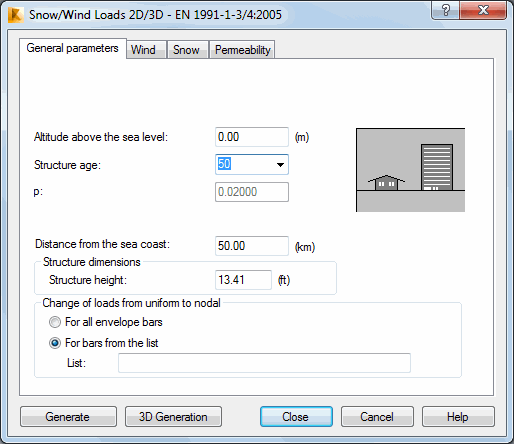Opening the Snow/Wind Load dialog and clicking the General parameters tab displays the following dialog.

The dialog has the basic options required by the national snow/wind code selected in the Job preferences dialog. When you select an option its diagram displays in the upper-right corner of the dialog.
For the snow and wind code, Eurocode1 (French version), the top of the dialog has the following options:
- Department - Specifies the department (district) where the structure is located.
- Canton - Specifies the canton (region) where the structure is located.
For the snow and wind code, Eurocode1 (Polish version), the top of the dialog has the following options:
- Wind zone - Specifies the code of a wind zone in which the structure is located.
- Snow zone - Specifies the code of a snow zone in which the structure is located.
The following options are available for all versions of the Eurocode1 snow and wind code:
- Altitude above the sea level - Specifies the altitude above sea level where the structure is located. Note: Altitude above sea level must be specified in meters.
- Structure age - Specifies the structure age n, which is used to calculate the annual probability of wind exceeding the velocity p = 1/n
- p - Specifies the annual probability of wind exceeding the velocity p, which is used to calculate a reference value for the average wind velocity pressure qref.
The method for calculating the reference value for the average wind velocity pressure qref can be found in the description of the parameters on the Wind tab.
In addition, for the snow and wind code, Eurocode1 (Polish version), the tab has the Angle between direction of wind from left and north direction parameter, which lets you define the angle between the vector normal to the left structure wall and the vector directed North.
The previous parameter is applied when defining the CDIR coefficient value for individual wind directions. In the Polish version of the snow and wind code, Eurocode1, the value of the CDIR coefficient depends on the geographical direction from which the wind blows.
The dialog is divided into several fields with certain groups of options. The top of the dialog has the Structure dimensions field, which includes the Structure height option for defining the height of a structure. This dimension is used to calculate wind pressure.
The Change of loads from uniform to nodal field has the following options:
- For all envelope bars - When selected, snow/wind loads generated for all bars of a structure envelope are changed to nodal loads.
- For bars from the list - When selected, snow/wind loads generated for selected bars of a structure envelope are changed to nodal loads. The selected bars must be entered in the List field. The list of bars can be selected manually (by specifying their numbers) or graphically. Snow/wind loads for selected bars are generated at bar nodes.